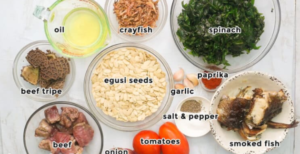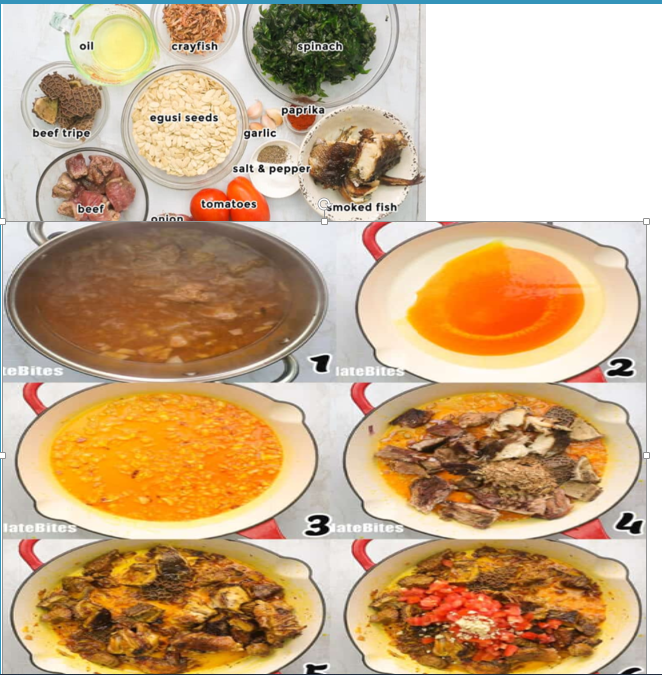Ingredients You Will Need for Preparing Egusi Soup

To make a delicious pot of egusi soup, you’ll need the following ingredients:
- Egusi (Melon seeds): 2 cups, ground
- Palm oil: 1 cup
- Beef or goat meat: 500g, cut into pieces
- Stockfish: 1 piece, soaked and deboned
- Dry fish: 1 medium, soaked and deboned
- Ponmo (cow skin): 1 cup, cut into small pieces
- Crayfish: 2 tablespoons, ground
- Pepper (scotch bonnet): 3-4, chopped or ground
- Onions: 1 large, chopped
- Bitter leaf or spinach: 2 cups, washed and chopped
- Ogiri or iru (locust beans): 1 tablespoon
- Seasoning cubes: 2-3
- Salt: to taste
- Water: as needed
These ingredients form the base of a traditional egusi soup. You can adjust the quantities based on your preference or the number of servings you need.
Step-by-Step Preparation Of Egusi Soup
1. Preparing the Ingredients
Before you start cooking, it’s important to prepare all your ingredients. Begin by grinding the egusi seeds into a fine powder using a dry mill or blender. Next, soak the stockfish and dry fish in hot water to soften them, then debone and break them into smaller pieces. Cut the beef or goat meat into bite-sized chunks, and wash the bitter leaf or spinach thoroughly to remove any dirt or sand.
Recommended Post: How to Prepare African Salad (Abacha): Serve Your Family With A Delicious Meal
2. Cooking the Meat
In a large pot, add the cut meat, chopped onions, seasoning cubes, and salt. Pour in enough water to cover the meat and bring it to a boil. Cook the meat on medium heat until it becomes tender. This should take about 30-40 minutes, depending on the toughness of the meat. Once the meat is cooked, remove it from the pot and set it aside, reserving the broth for later use.
3. Frying the Egusi
In a separate pot, heat the palm oil over medium heat until it becomes hot, but not smoking. Add the ground egusi to the oil and stir continuously to avoid burning. Fry the egusi for about 10-15 minutes, allowing it to absorb the oil and develop a deep, rich color. This step is crucial as it enhances the flavor of the egusi and gives the soup its characteristic texture.
4. Adding the Meat and Fish
Once the egusi is well-fried, gradually add the cooked meat, stockfish, dry fish, and ponmo into the pot. Stir everything together to ensure the meat and fish are well coated with the egusi mixture. Pour in the reserved meat broth and add more water if necessary to achieve your desired consistency. Allow the mixture to simmer for 10-15 minutes, giving the flavors time to meld together.
5. Incorporating the Vegetables
After the soup has simmered, it’s time to add the vegetables. Stir in the washed and chopped bitter leaf or spinach. If you’re using bitter leaf, ensure it has been thoroughly washed to remove its bitter taste. Let the soup cook for another 5-7 minutes, just long enough for the vegetables to wilt and integrate into the soup without losing their vibrant color and nutrients.
6. Final Seasoning
At this stage, taste the soup and adjust the seasoning if needed. Add more salt, pepper, or seasoning cubes to suit your taste. If you like your soup spicier, you can also add extra ground crayfish or scotch bonnet peppers at this point. Finally, add the ogiri or iru for an authentic, earthy flavor that ties the dish together.
7. Simmer and Serve
Allow the soup to simmer for an additional 5 minutes on low heat. This final simmering helps all the ingredients blend harmoniously, resulting in a deeply flavorful and satisfying egusi soup. Once done, remove the pot from the heat and let it sit for a few minutes before serving.
Serving Suggestions
Egusi soup is traditionally served with a variety of Nigerian staples such as:
- Pounded yam: A smooth, elastic dough made from yam, it is the perfect companion for soaking up the rich soup.
- Eba (garri): Made from cassava flour, eba is a popular and easy-to-make side that pairs beautifully with egusi.
- Fufu: This can be made from cassava, plantain, or cocoyam, and is a common accompaniment for soups like egusi.
- Semolina: A soft, dough-like side made from wheat flour, semolina offers a slightly different texture and taste.
To eat, simply scoop a portion of your chosen side, dip it into the soup, and enjoy the rich, savory flavors.
Tips for the Perfect Egusi Soup
- Use Fresh Ingredients: Fresh vegetables, meats, and spices enhance the flavor and nutritional value of the soup.
- Control the Oil: While palm oil is essential, too much can make the soup greasy. Use just enough to fry the egusi without overwhelming the dish.
- Fry the Egusi Well: Properly frying the egusi is key to achieving the right texture and taste. Be patient during this step and stir continuously to avoid burning.
- Balance the Flavors: Adjust the seasoning to your preference, but be mindful of the balance between the salty, spicy, and earthy elements in the soup.
Conclusion
Egusi soup is more than just a meal; it’s a celebration of Nigerian culinary tradition. With its rich, hearty flavors and satisfying texture, it’s no wonder this dish is loved by many. By following this guide, you can prepare an authentic and delicious pot of egusi soup that will impress your family and friends.


